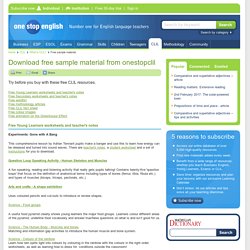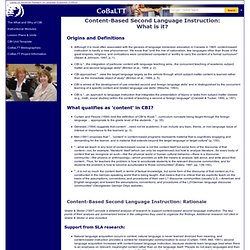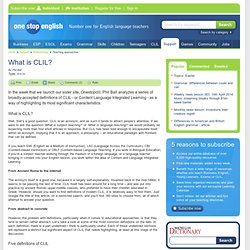

Download free sample material from onestopclil. Try before you buy with these free CLIL resources.

Free Young Learners worksheets and teacher's notesFree Secondary worksheets and teacher's notesFree wordlistFree methodology articlesFree CLIL fact sheetFree colour imagesFree animation on the Greenhouse Effect Free Young Learners worksheets and teacher's notes Experiments: Gone with A Bang This comprehensive lesson by Adrian Tennant pupils make a banger and use this to learn how energy can be released and turned into sound waves. There are teacher's notes, a student worksheet and a set of instructions for you to download. Question Loop Speaking Activity - Human Skeleton and Muscles A fun speaking, reading and listening activity that really gets pupils talking! Arts and crafts - A shape exhibition Uses coloured pencils and cut-outs to introduce or review shapes. Science - Food groups A useful food pyramid clearly shows young learners the major food groups.
Geography - Symbols on maps History - Famous explorers History – Christopher Columbus. Editorial: Focus on the CLIL 2010 Conference. By Keith Kelly Keith Kelly reports from the CLIL 2010 Conference in Eichstätt and shares highlights of the event and related resources on the site.

Dear readers, My editorial comes to you live from Eichstätt, the venue for the CLIL 2010 Conference. I met and talked with dozens of people, all with their own CLIL stories and experiences, so, this month, I will relate some of them to you and link to some relevant resources on onestopclil. Opening and welcome Oliver Meyer was our host at the Catholic University of Eichstätt and he gave us all a warm welcome on the damp and misty autumn day of our arrival. Isabel Peres Torres gave a speech on IT in education and presented Web 3.0 technology, inviting us to explore its exploitation in CLIL contexts. Keynote messages The keynote session was presented as a cascade event with several speakers following in quick succession. Hugo Baetens-Beardsmore kicked off proceedings in his inimitable style and reported on 'The Brain: An Educational Perspective'. The language dimension of CLIL. Keith Kelly argues that language, and an explicit focus on it, is at the heart of CLIL methodology.

There is a good deal of debate going on in CLIL about the role of language within this approach to learning. Some colleagues place little stress on the foreign language in their classrooms believing that their job is to teach through the medium of the foreign language and not to develop that foreign language. This article offers discussion on the role of language in CLIL approaches and argues that language, and an explicit focus on it, is at the heart of CLIL methodology.
Figure 1: Range of contextual support and degree of cognitive involvement in language tasks and activities (Cummins 2001). Need for an extra dimension I've used this diagram for a long time and yet had a feeling that there is an aspect missing or that the shape is not right when applied to CLIL situtations. CoBaLTT: Why CBI? Origins and Definitions Although it is most often associated with the genesis of language immersion education in Canada in 1965, content-based instruction is hardly a new phenomenon.

We know that "until the rise of nationalism, few languages other than those of the great empires, religions, and civilizations were considered competent or worthy to carry the content of a formal curriculum" (Swain & Johnson, 1997, p. 1). CBI is "...the integration of particular content with language teaching aims...the concurrent teaching of academic subject matter and second language skills" (Brinton et al., 1989, p. 2).
CBI approaches "...view the target language largely as the vehicle through which subject matter content is learned rather than as the immediate object of study" (Brinton et al., 1989, p. 5). What qualifies as 'content' in CBI? CLIL Links for the Key Stages / UK Curriculum. CLIL Practice: Perspectives from the Field. What is CLIL? By Phil Ball In the week that we launch our sister site, Onestopclil, Phil Ball analyzes a series of broadly-accepted definitions of CLIL - or Content Language Integrated Learning - as a way of highlighting its most significant characteristics.

What is CLIL? Well, that’s a good question. CLIL is an acronym, and as such it tends to attract people’s attention. If we were to ask the question ‘What is subject teaching?’ If you teach EMI (English as a Medium of Instruction), LAC (Language Across the Curriculum), CBI (Content-based Instruction) or CBLT (Content-based Language Teaching; if you work in Bilingual Education; if you’re a subject teacher working through the medium of a foreign language, or a language teacher bringing in content into your English lesson, you work within the area of Content and Language Integrated Learning. From Ancient Rome to the Internet The acronym itself is a good one, because it is largely self-explanatory. From abstract to concrete Five definitions of CLIL 1. 2. 3.